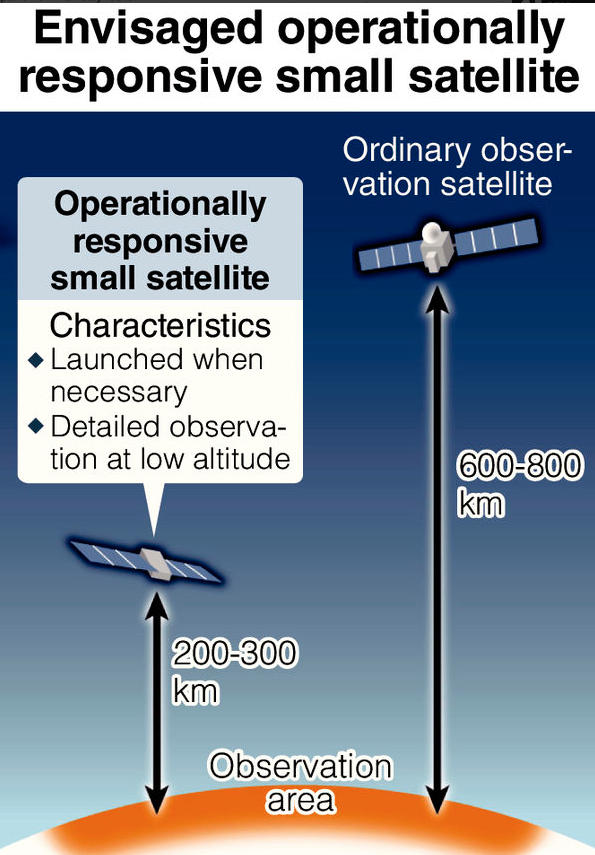[SatNews] The new basic plan said the government will consider enhancing the capabilities of information-gathering satellites.
The government’s new basic plan on space policy, which was finalized Friday, emphasizes national security and industrial development but mentions little about space exploration or other matters related to basic science.
The basic plan stressed that the nation’s information-gathering capacity will be enhanced by utilizing satellites. It also revealed a numerical goal of developing the aerospace-related industries in “both the public and private sectors into industries worth ¥5 trillion over a decade”—an inclusion apparently made in consideration of industrial circles.

The plan comprises the government’s 10-year aerospace policy from fiscal 2015 set by the Strategic Headquarters for Space Development, which Prime Minister Shinzo Abe chairs. The former plan has stipulated a five-year policy from fiscal 2013, but Abe ordered the strategic headquarters to revise the plan in September because of changes in security situations surrounding Japan, meaning the old plan will last only two years.
“We have succeeded in making the new plan specific, and it reflects up-to-date security policies,” Abe said Friday at a meeting at strategy headquarters.
Regarding national security, the new basic plan stipulates increasing the number of quasi-zenith satellites—which are used to build a high-precision positioning information system, or the Japanese version of the U.S. Global Positioning System—from the current one to seven. The Japan Aerospace Exploration Agency will start cooperating with the Defense Ministry, the basic plan said.
The new basic plan said the government will consider enhancing the capabilities of information-gathering satellites, which are virtually the same as intelligence satellites, as well as discussing the necessity of introducing early-warning satellites that would monitor the launch of missiles.
Prof. Hiroaki Akiyama, a specialist in space policies who serves as director of the Wakayama University’s Institute for Education on Space, expressed support for the new basic plan, saying, “Considering the limited financial resources, it is an inevitable consequence that the government places the focus on national security, as its necessity is clear.”
Reflecting requests from industrial circles to show a long-term timetable on space policy, the basic plan also set specific periods for the launch of artificial satellites to help aerospace-related companies create business plans.
Satoshi Tsuzukibashi, director of the Industrial Technology Bureau of the Japan Business Federation (Keidanren), asked the government for further efforts on the basic plan, saying, “I’d like the government to make it more concrete at annual reviews.”
Meanwhile, almost nothing was mentioned about new projects on basic science-related matters such as planetary exploration and manned space development. Regarding whether to extend the period of joining the International Space Station, the basic plan only stated, “A conclusion will be drawn by the end of fiscal 2016.”
“Achievements in basic research has helped Japan gain trust” from other nations, said Akira Sawaoka, president of Nagoya-based Daido University, who specializes in space utilization strategies. “Basic research is something that should never be easily cut.”
The government will start full-fledged discussions in next fiscal year on the development of an expendable small observation satellite, which could be launched immediately in such eventualities as a natural disaster or a military emergency, it has been learned.
The new satellite could be used for rescue and information-gathering activities, according to government sources.
The envisaged satellite is referred to as an operationally responsive small satellite. Its development is included as a subject for discussion in a draft of the Basic Plan on Space Policy, which was released in autumn by the government’s Committee on National Space Policy.
A preassembled satellite, measuring 70 centimeters in length, width and height, would be launched with a camera and other equipment in case of emergency. It weighs from 100 kilograms to 150 kilograms.
The satellite would fly at a relatively low altitude of 200 kilometers to 300 kilometers, half that of an ordinary observation satellite, to observe a targeted area in detail. The satellite would burn up upon reentering the atmosphere about a week after launch.
The government plans to establish a working group jointly with the Cabinet Office, the Education, Culture, Sports, Science and Technology Ministry and the Defense Ministry.
Currently, Japan possesses the Daichi-2 Earth observation satellite and information-gathering satellites, but does not have enough satellites to observe specific areas thoroughly. The government will discuss using expendable small satellites to cover the shortage.

